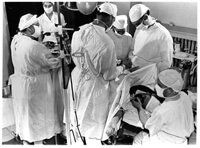After World War II, many immigrants to the United States, including Holocaust survivors, had physical concerns to deal with such as TB. National Jewish was one of the few United States medical institutions to respond to these immigrants’ needs. In 1953, with the assistance of the United Nations World Health Organization, the hospital became a clearinghouse for displaced persons suspected of having TB.
Also after the war, National Jewish began to accept new treatment methods. It embraced a holistic approach that addressed psychiatric concerns of patients who had been hospitalized for years, in addition to their physical ailments. And it was one of the first hospitals to use chemotherapy for treatment of TB when streptomycin first became available in 1946.
In the 1950s, research at National Jewish influenced another approach to treating TB. The new treatment approach focused on drug therapy and eliminated bed rest, substituting it with physical activity, which helped the drugs work better.
Expansion of Services
 In 1948, the National Jewish administration decided to expand the hospital’s services into cardiology. Within a few years, a surgical team was created to perform the difficult heart valve operation, mitral commissurotomy, which until then had been performed only in the East. Throughout the next few decades faculty produced pioneering work in open-heart surgery and even had a waiting list of patients. Despite the programs success, the hospital began to pursue a tight focus on respiratory disease, and the cardiology program was discontinued in 1968. (Only to be reestablished almost 40 years later in 2007.)
In 1948, the National Jewish administration decided to expand the hospital’s services into cardiology. Within a few years, a surgical team was created to perform the difficult heart valve operation, mitral commissurotomy, which until then had been performed only in the East. Throughout the next few decades faculty produced pioneering work in open-heart surgery and even had a waiting list of patients. Despite the programs success, the hospital began to pursue a tight focus on respiratory disease, and the cardiology program was discontinued in 1968. (Only to be reestablished almost 40 years later in 2007.)
By the mid 20th century, asthma and other allergic diseases were becoming recognized as an increasing health menace that afflicted millions. So, as TB treatment improved and the need for TB beds began to diminish, an asthma and allergy program was introduced to National Jewish in the mid-1950s. And in 1959, the nation's first large inpatient adult asthma service was created.
The allergy and asthma programs set the stage for National Jewish to branch out from TB treatment and eventually become a world-renowned center for lung disease treatment and research.
Clinical History (3 of 3)
Page 1, 2, 3